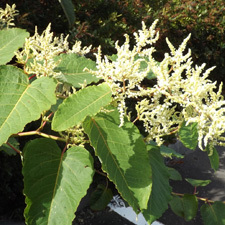 Giant knotweed
Giant knotweed
Common name: Giant knotweed
Botanical name: Fallopia sachalinensis
Management category: Advisory
Originally from Asia. It was introduced to New Zealand as an ornamental species and was recorded as naturalised in 1935.
Why is it a pest?
- Forms dense, long-lived thickets which excludes other species and prevent native seedlings from establishing.
- Grows extensively from rhizomes and multiple stems.
Where is it found?
Giant knotweed can be found in disturbed shrubland and bare land.
What does it look like?
- Giant, many-stemmed, thicket forming perennial shrub with roots and rhizomes and numerous hairless green stems that are woody at the base.
- Ovalish and pointed leaves with more than 14 pairs of lateral veins that are blueish below and usually on reddish stalks.
- White or greenish flowers in densely-hairy, clusters appear from November to April, but no seed is produced in New Zealand.
What are the rules?
Advisory
Council does not enforce the control of advisory species. It is landowner/occupier responsibility to manage these pests. Council may provide advice on how to manage or control advisory species if required.
How do you get rid of it?
- Dig-out (all year) – small patches, dispose by incineration or transfer station.
- Weed mat – Leave for six months minimum.
- Cut and paste with herbicide (all year)
- Stem inject with herbicide (all year)
- Foliar spray (Spring to Autumn)
CAUTION: When using any herbicide or pesticide, PLEASE READ THE LABEL THOROUGHLY to ensure that all instructions and directions for the purchase, use and storage of the product, are followed and adhered to.
Read more on pest control advice, information and regulations.
Images








